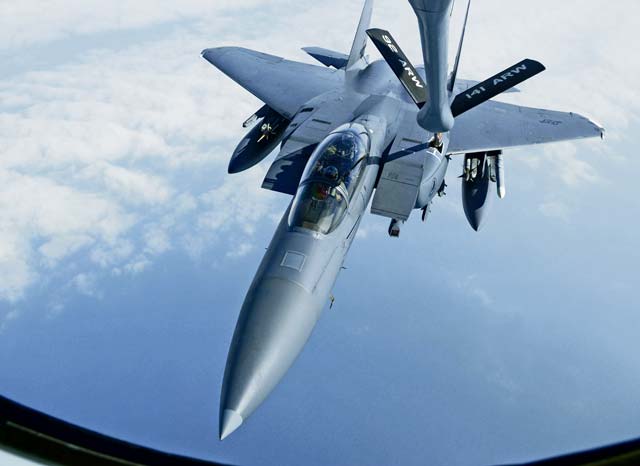
An F-15E Strike Eagle from Royal Air Force Lakenheath, England, takes on fuel from a KC-135 Stratotanker from RAF Mildenhall March 28 during Exercise Tonnerre Lightning.
British, French and U.S. airmen wrapped up the inaugural Exercise Tonnerre Lightning 14-1 Friday on Ramstein and other operating locations.
The tri-lateral exercise, which replicates a coalition response to a contingency operation, developed as a method for the U.S., the United Kingdom and France’s air forces to strengthen their combined interoperability.
“We are always looking for ways to exercise and improve our methods as allies,” said Brig. Gen. Christopher J. Bence, Joint Forces Allied Air Component commander for the exercise. “We are extremely fortunate that our forward-based presence allows us to constantly train with our French and British allies.”
The first of these multiple tri-lateral exercises, which has been in the planning phase for over six months, focused on communications integration and interoperability to support air operations.
Partner nations synchronized command and control efforts at the 603rd Air and Space Operations Center at Ramstein while deployed forces conducted training operations off the coast of England.
“This exercise allowed us to test and refine secure communications with our close partner nations,” said Maj. Jan-Peter Linch, U.S. Air Force action officer for the exercise. “In a short amount of time, our three nations’ teams effectively validated significant capabilities that are crucial to the success of our tri-lateral operations.”
Planners coordinated and directed a large-scale air campaign including aircraft from the 48th Fighter Wing and the 100th Air Refueling Wing along with allied strike, refueling and airborne control aircraft.
Friendly forces conducted strikes against simulated enemy targets while simultaneously fighting enemy air forces, all played by allied fighters.
The overall goal for the exercise was to smooth out complications that arise when communicating between air forces, Linch said.
“The training is aimed at reinforcing a common understanding between partner nations,” he said. “This allows for more effective operations at any given time while strengthening our combined capabilities.”
During contingencies, allied air coalitions can be quickly assembled to meet desired objectives, which can range from delivering humanitarian assistance to launching air strikes.
The U.K., France and the U.S. have continuously collaborated over the years to provide airpower assistance on numerous occasions, including Libya in 2011, and the recent crises in Mali and the Central African Republic.
“Based on past experiences with our allies, I have seen our effectiveness at quickly putting teams together and achieving the objectives,” said Squadron Leader Gordon Ferguson, U.K. action officer for the exercise. “But this success does not come without complications. That’s the advantage of practicing — we can refine our processes together through robust training exercises.”
Tonnerre Lightning is planned to be held twice a year with the command rotating among the three
nations.
While this iteration was led by the U.S., the next Tonnerre Lightning will be led by France later this year.
“The goal for each exercise is to become progressively more complex than the previous one,” said French Lt. Col. Pascal Sotty, director of the French JFAC in Lyon. “For this iteration we focused on communications and creating the products needed for forces to effectively talk, plan and execute the mission. We look forward to the next opportunity together to test our procedures.”


